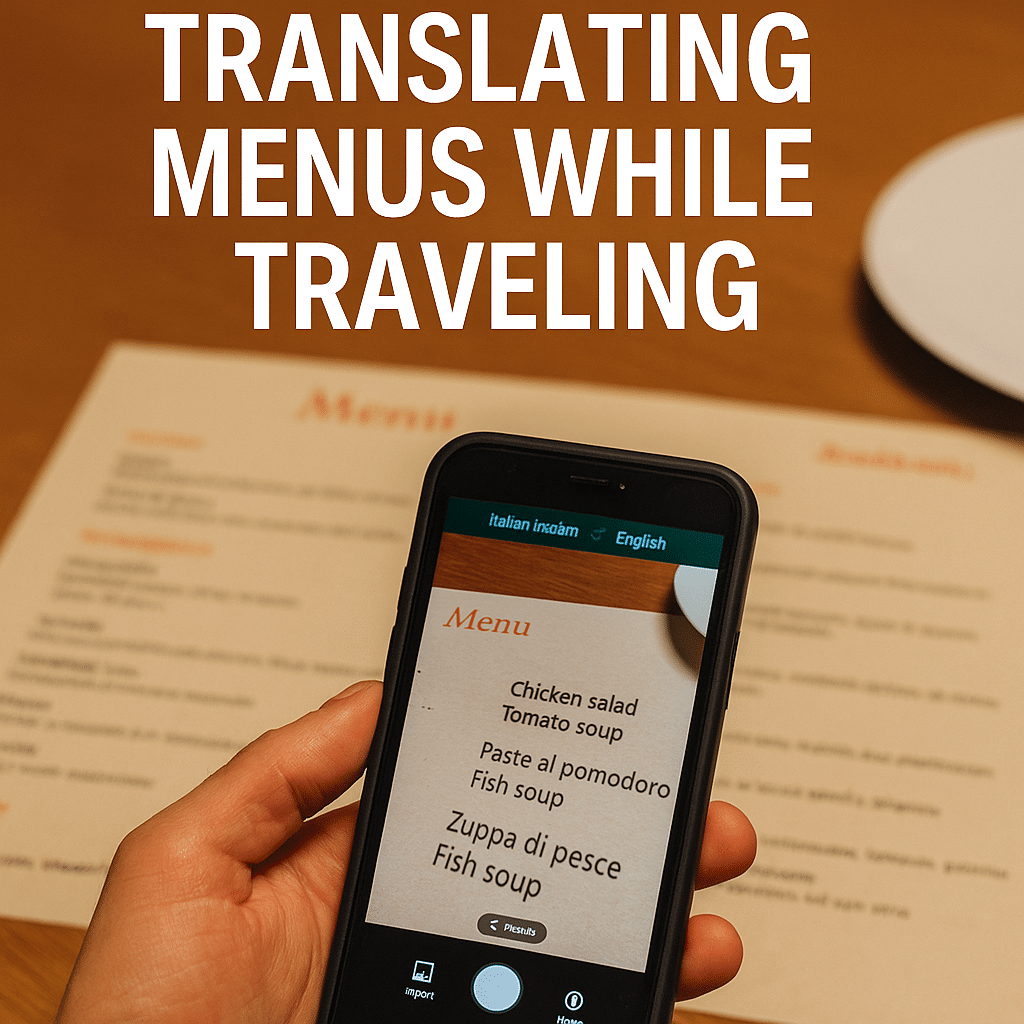Struggling with foreign menus on your travels? This guide reviews top apps like Google Translate and iTranslate that make translating menus easy and safe.
Best Apps for Translating Menus While Traveling: Best Apps for Traveling
Traveling to a new country can be exciting, but translating menus while traveling can make ordering food feel like a guess. For example, a traveler in Tokyo might face a sushi menu written in kanji with no English. Without help, it’s hard to know what to order, but translation apps can solve that instantly.

In fact, one survey found that about one in three travelers feel worried about not knowing the local language. Tourists even list reading menus as a major travel challenge. The good news is smartphone translation apps can make translating menus easy and safe. All of these tools are especially handy for translating menus on the go. This guide highlights the best menu translator apps for travelers and gives tips on how to use them.
Why Menu Translation Apps Matter
Language barriers often cause trouble for travelers. Many people don’t learn local phrases before trips. In one survey, fewer than one out of three travelers bothered to learn even basic words in the local language.
If you sit down at a restaurant and only see strange words, it feels like a puzzle instead of a menu. The TransPerfect travel survey found that dining out – including reading menus – was one of the top obstacles for tourists overseas. In other words, a simple meal can become stressful when you can’t tell what each dish is. Translation apps solve this by instantly converting menu text into a language you understand.
- Travel frustration: One survey found that reading menus and ordering food was a top travel worry. An app can ease this stress by quickly translating dish names so ordering is faster and more fun.
- Safety: Knowing the ingredients (like nuts, seafood, or dairy) is vital. Translation apps help avoid surprises by showing you what each dish contains. This is especially important if you have food allergies or dietary restrictions.
- Cultural adventure: Understanding the menu lets you try local specialties with confidence. Apps take away the guesswork so you can enjoy new foods like a local.
- Confidence: With a translation app in hand, you can order with confidence. You’ll know exactly what you’re asking for, which makes dining out far more enjoyable.
How Menu Translation Apps Work
When translating menus, these apps act as your personal interpreter. Menu translation apps typically use your phone’s camera or microphone and advanced software. For example, Google Translate lets you point your phone camera at a menu and instantly see English text overlaid on the image. This works because of OCR (Optical Character Recognition) – the app scans the photo, recognizes the words, and then translates them. Many apps also let you type or speak a menu item to get a translation. When you do, the app’s language engine finds the best match in real time.
Google has made its translation software smarter. In 2018 it added offline neural-network translation for 59 languages, which means even without internet the app can give high-quality results. Other apps use similar AI technology to improve accuracy. For instance, Microsoft Translator supports text, speech, and image translation for over 100 languages, so it can handle menus from many countries. Offline downloads work like having a phrasebook in your pocket: just download the language before you go, and you can still translate menu text in the restaurant. Over time the app also “learns” from corrections and gets better.
Key Features to Look For in a Menu Translation App
When choosing an app for translating menus, check for these useful features:
- Camera/OCR mode: The app should take a picture of the menu and translate it instantly. Google Translate supports instant camera translation in 94 languages, meaning you just point your camera at the menu and get a translation overlay – making it great for translating menus on the go. Some apps even let you import a saved photo of a menu. This tech works by scanning the image, recognizing text, and displaying the translated text on your screen.
- Offline support: If you will be without data service, offline mode is critical. Google Translate lets you translate without internet in 59 languages, and iTranslate supports offline translation in 38 languages. Google Translate’s advanced offline mode now uses neural AI for 59 languages. Before your trip, download the language packs for the countries you visit. Then even without Wi-Fi, you can translate any menu text – perfect for translating menus even in remote areas.
- Language coverage: Make sure the app covers the languages you need. For example, Google Translate alone supports over 100 languages, and iTranslate covers over 100 languages as well. Microsoft Translator offers text and image translation in over 100 languages. Papago by Naver specializes in Asian languages like Korean, Japanese, and Chinese. If you travel to Europe or Asia, double-check your app includes the local language(s) to ensure accurate menu translation.
- Accuracy and food terms: Some apps include food-specific dictionaries or understand context better. For example, Waygo specializes in Asian food menus and even shows little icons of foods with the translation. Apps that have seen many menu examples will tend to give clearer menu translations for local dishes.
- Voice and conversation mode: It helps if the app can speak out the translation. Both iTranslate and Microsoft Translator include speech translation. You can speak the menu item and hear it read back clearly. For example, you could say a dish name and hear its pronunciation in the local language – great for translating menus when you want to make sure you’re saying it right. Microsoft’s app even handles live group conversations, so you and a local waiter could talk back and forth on-screen. This is useful for double-checking a menu reading or practicing pronunciation.
- Favorites or phrasebook: Features to save or star frequent translations can speed up ordering. If you often eat at the same type of restaurant or revisit a place, saving phrases will save time. For example, you might save your favorite dish names and immediately see them next trip.
- App integration: Some translation tools work system-wide. For example, Google Lens can translate text from inside any app or image. This lets you quickly translate any menu by pointing your camera at it or copying text in another app.
Choosing an app with these features will make menu translation much easier and more accurate. Always test the app before you travel so you know how to use it. Many travelers wonder how to translate a menu without internet; the answer is to use the apps’ offline mode or offline packs, as mentioned above.
Side-by-Side Comparison of Top Menu Translation Apps
Here’s a complete side-by-side breakdown of the top translation apps based on essential features for travelers:
| App Name | Free or Paid | Number of Languages Supported | Key Features | Advantages | Disadvantages |
|---|---|---|---|---|---|
| Google Translate | Free | 108 (text), 94 (camera), 59 (offline) | Text, voice, camera, offline mode, instant camera overlay | Free, accurate, broad language support, strong offline mode | Occasionally incorrect translations, lighting-dependent camera mode |
| iTranslate | Free with Pro version | 100+ (38 offline with Pro) | Voice, text, offline packs (Pro), Apple Watch support | Clean UI, voice slow-down, sync across devices | Paid Pro needed for offline, fewer camera features than Google |
| Microsoft Translator | Free | 100+ | Text, voice, image, real-time conversation, phrasebook | Conversation mode, cross-device sync, integrated with Microsoft tools | Camera translation not as strong as Google, UI slightly less intuitive |
| Papago | Free | 13 | Text, voice, camera, handwriting, slang/context-aware translations | Great for Asian languages, free, smart contextual translations | Limited to East Asian languages |
| Waygo | Free for limited use | 3 | Instant camera translation, works offline, food-specific icon overlays | Offline support, focused on menus, fast and simple | Only 3 languages, no text/voice input |
| TripLingo | Free with paid features | 100+ | Phrasebook, voice translator, culture tips, expense tools | Multi-tool for travelers, cultural awareness, audio support | Busy interface, more complex than others, some tools require payment |
| SayHi Translate | Free | 90+ | Text, voice, audio playback, natural-sounding speech | Very easy to use, good for conversation, excellent voice clarity | No image/camera translation, basic interface |
Best Menu Translator Apps for Travel
Travel experts agree on these choices. All of the apps below can assist with translating menus while you travel. A travel blog, for example, lists Waygo, Papago, TripLingo, Google Translate and others as top translator apps for travelers. Below are some of the best apps you can use to translate menus:
Google Translate
Google Translate is a top pick for many travelers. It supports typing in 108 languages and has a powerful camera mode for 94 languages, including most European and Asian languages. Point your camera at a menu to translate entire pages instantly. Google Translate also works offline (you can download packs for 59 languages) so it’s useful where internet is spotty. The app offers a conversation mode if you want to talk to a local in real time. Because it’s free and constantly updated, it’s a reliable all-around tool.
Google Translate also integrates deeply with Android. For example, the “Tap to Translate” feature works system-wide: copy a foreign dish name and a pop-up will show the English. The app saves your starred translations in your Google account, which is handy if you revisit the same menu later. The app’s large database usually handles slang and colloquial terms, though sometimes it still makes funny mistakes. For example, a traveler once asked Google to translate the French phrase “Je suis avocat” and it replied “I am an avocado” – a reminder that no app is perfect. Always double-check important items. Overall, Google Translate’s offline mode and free cost make it the default choice for many travelers.
iTranslate
iTranslate is another popular travel app. It supports both Android and iOS and even has an Apple Watch app. The interface is clean and user-friendly, with an integrated dictionary. iTranslate covers over 100 languages and lets you speak or type for instant translation. It also offers offline language packs for 38 languages if you upgrade to the Pro version, which is handy without internet.
A neat feature is that you can slow down the spoken output to hear how a word sounds, which helps if you want to ask your waiter. Many users compare iTranslate and Google: Google covers more languages, but iTranslate’s interface is very clean and easy. The app syncs your translation history across devices if you log in. Because of its ease of use and range of languages, iTranslate is a solid choice for menu translation on the go.
Microsoft Translator
Microsoft Translator is a free app that works across text, voice, and images. It supports over 100 languages and can translate photos of text, making it great for menus. One standout feature is its conversation mode: two people can speak into two phones, and each will see their language translated on screen. In practical terms, you could have a waiter and yourself both talk and see each other’s words translated. This split-screen chat mode is easy and fast for quick interactions.
Microsoft’s app also works offline for many languages and even has a built-in phrasebook for common expressions (like ordering food or asking questions). It’s integrated with Windows and some web browsers, making the same translation tools available on computers too. Many travelers like Microsoft Translator for its speed on text, though its camera mode is best for major languages (Google may still be slightly better on some scripts). Overall, it’s an excellent free backup app for translating menus and everyday conversation.
Naver Papago
Papago is a translator app from Naver that excels at Asian languages. It covers Korean, Japanese, Chinese, and a few others very well. Papago offers text, voice, and image translation. If you are in Japan or Korea, its camera mode will accurately translate menu text written in local scripts. It also has handwriting input: you can draw a character on the screen and Papago will recognize it and translate. Papago includes a handy dictionary and example sentences for words, which can help if a word is confusing. The app is completely free and tailored for Asian travel.
It even has a “slang” mode for casual phrases, and some users find Papago captures context better than other apps. For example, it often suggests alternative translations if a word has multiple meanings. Papago is a favorite for many travelers in East Asia because it often feels more natural with Korean and Japanese. In short, Papago is an excellent companion for translating menus in Japan or Korea.
TripLingo
TripLingo is an all-in-one travel app with a focus on communication. It includes a large phrasebook (over 2,000 phrases) and thousands of audio clips. For translating menus, you can speak into TripLingo and it will play back the translation, helping you pronounce it correctly. It also has a built-in tip calculator and currency converter. TripLingo is free with optional paid upgrades. Its interface can feel busy because it covers many functions, but travelers like that it combines language help with cultural advice. It’s especially useful if you need more than just menu translation – for example, asking about ingredients or local etiquette. TripLingo is a handy all-around tool, though some users prefer simpler apps just for quick menu lookup.
SayHi Translate
SayHi Translate covers about 90 languages and focuses on voice translation. You speak or type a phrase, and SayHi shows both the original and translated text along with spoken audio. It’s praised for its natural-sounding voices. While SayHi doesn’t have a camera mode, it excels at conversation. For example, you could speak a dish name and hear it pronounced in the local language before ordering. The app is free and extremely easy to use, which means even kids or seniors can operate it without confusion. SayHi is a good backup app for quick clarifications at the table or short conversations.
Tips for Translating Menus
- Download languages beforehand: Install language packs in your app before you leave. Google Translate’s advanced offline mode supports 59 languages. This way you can translate entire menus offline without extra data.
- Use good lighting: When using camera translation, make sure the menu is flat and well-lit. A clear photo means the text can be recognized accurately, which makes translating menus much easier.
- Try multiple apps: Sometimes apps differ. If one app’s result is unclear, try another to confirm. Many travelers search for “menu translator app” or “how to translate a restaurant menu” online. The apps above frequently top those lists. Double-checking translations in a second app can catch mistakes.
- Learn a few key words: Even with apps, knowing words like “spicy,” “allergy,” “vegetarian,” or local specialty names can help. Plus it shows respect to locals. Learning basic food words makes translating menus faster and more accurate.
- Ask politely: If you’re still unsure, try a simple phrase or gesture. You might say in their language, “Can you help me translate this?” or simply show the translated phrase. Many servers appreciate the effort and may explain the menu item.
- Be cautious with slang: Some dishes use local slang or brand names. If an app’s translation looks odd, try searching the term online or asking a local. Apps can also struggle with cultural names.
- Double-check important items: For allergens or ingredients, confirm them carefully. Apps can mess up – one traveler’s app even mistranslated “lawyer” to “avocado”. Always double-check anything critical.
Conclusion
Using a good menu translation app can turn dining abroad into an adventure instead of a headache. With apps like Google Translate and iTranslate, you can decode menus on the fly. Others like Papago and Waygo specialize in certain languages. Translating menus will no longer be a worry on your trip. For more travel tips and app recommendations, check out our Touring Diary Adventure blog, where we share more advice for smooth travel experiences. Thanks to these tools, you can enjoy local cuisines with confidence.





